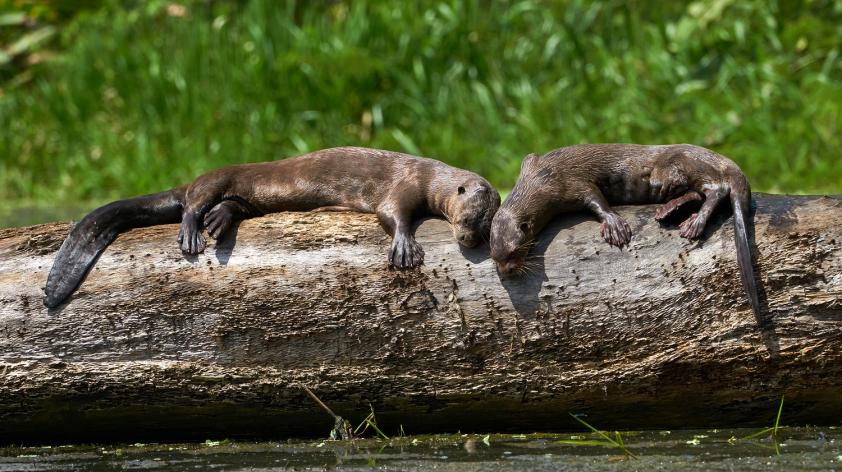
Boy or Girl? The Challenge of Sexing Giant Otters
Day 4, 9 am, Cocha Cashu, Manu National Park, Peru. The water boils and churns as nine endangered giant otters vigorously pursue a school of fish. One otter swims under and up, and sends a spray of panicked boca chicos into the air. Another bursts from the water and I see it twist and catch a fish in mid-air before both plunge back into the lake.
Moments later, the otter resurfaces and, firmly grasping its prize between large, webbed feet, begins to devour it, head first and with great relish.
Overhead, an osprey launches itself from its observation point high in a tree, swoops down, and hurls itself into the fray. It comes up empty-clawed and I watch it shake itself, like a shaggy dog, in mid-flight.
The otters hum to one another and all begin to head in one direction, towards the far end of the lake. Will they now take a break from the serious business of hunting? Will I get the chance, finally, to sex the remaining individuals of the group?
Each giant otter has a distinctive white pattern on its throat that allows researchers to identify it from birth. It is a relatively simple matter, when monitoring a population, to film or photograph the throat markings, and thus follow the life histories of individuals over time. Sexing giant otters, on the other hand, can be a significant challenge.
In the wild, it is only possible to determine the gender of individuals when they are observed out of the water, usually during resting and grooming sessions. Adult females with a litter will have an ‘udder’ and engorged teats while those who have nursed young have four permanently elongated teats (due to prolonged lactation).
Adult males are readily distinguished by the obvious presence of testes (the male’s scrotum does not become clearly evident until he is at least one year old). However, gender is more difficult to determine in adult females that have not lactated, or in cubs and juveniles of both sexes.
In 2002, we stumbled upon a simple and effective method of sexing giant otters of all ages while they were using a latrine.
Otters often defecate and urinate simultaneously, with scats having a semi liquid consistency. We found that males can be told apart from females by the greater distance between the sources of the urine and faecal streams, that is, the genital and anal openings. When viewed broadside on, the male’s urine stream has its source between the hind legs and the orientation of the stream is to the rear at a 45-60 degree angle.
In females, the source of urine is close to the base of the tail and the stream projects downwards. In both males and females, the scat drops directly below the anus at the base of the tail. Hence, in males, the two streams often bisect each other with the urine stream landing beyond the scats, while in females they are parallel.
The only problem? It is often impossible to observe giant otters on latrines, since these are usually obscured by a curtain of overhanging vegetation. On Cocha Cashu, all giant otter latrines are invisible.
Only one option remains: to follow the otters during the course of a morning in the hope they will climb out on fallen trees to groom and bask in the sun.
Giant otters spend about 60% of their day foraging and though they are creatures of routine to a certain extent, there's no way of predicting if, when, and where a family will decide to take a break from fishing. First and foremost, appetites must be satisfied. This means I might spend up to 5 or 6 hours at a stretch in a small, cramped boat, several days in a row. Waiting…
The otters slowly make their way along the shore and I follow, carefully maintaining a distance that will permit them to be comfortable in my presence without significantly affecting their behaviour. Most importantly, and this is not always easy, I try not to get in the way.
The sun is ferocious, I've forgotten to bring water, and I think longingly of a cold shower. But the otters are heading towards the one place where I might see them haul out of the water. So I stick with them. And wait.
Half an hour later, my perseverance is rewarded.
One by one the otters climb up a fallen tree and begin to rub the entire lengths of their bodies against its warm, dry trunk. Trying to calm my breathing (the excitement never wanes), I take dozens of photos, of otters walking, grooming, playing, marking, dozing, writhing, and tumbling into the water. At one point there are six otters on the log, including two 4-5 month-old cubs.
Best of all, I finally manage to confirm what I had begun to suspect: one otter, called Fortunato, should really have been named Fortunata - she's a three-year old female. Another individual, Batman, born in 2016, is unmistakeably male. I will probably not see him again, at least not on Cashu. Experience in Manu has shown that by age four years, all male giant otters have dispersed from their birth lakes.
By 11:30am, all otters but one have entered the den at the base of the fallen tree. It's time for the cubs to rest and for me to escape the sun. The sexing of the two cubs will have to wait until they are older.
I just hope it won't take another three years before I get the opportunity.













